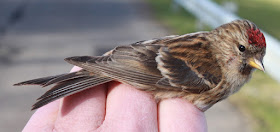The weather is staying cool with the lack of summer/spring birds unsurprising despite in recent years our becoming accustomed to many species appearing somewhat early. But then we are still in March with the weather and winds less than ideal to help birds travelling many miles to get here to North West England. In some years nothing much happens until April and it looks like 2016 is shaping up to be one of those.
With rain forecast for both early and late week Thursday was pencilled in as the possible day for a ringing session. The prediction was spot on when at 0545 the sky was clear with a hint of frost in the air. I switched on the heated seat and set off for another 0630 start up at Oakenclough.
Andy and I met up in the car park and then we set to with a couple of nets. The morning was mainly slow and steady with a sudden rush of Siskins after 1030 which boosted our catch to 32 birds of a mixed 8 species, dominated once again by finches: 13 Siskin, 10 Lesser Redpoll, 2 Chaffinch, 2 Goldfinch, 2 Coal Tit, 1 Blackbird, 1 Wren and 1 Dunnock.
Including today and to date in 2016 we have ringed 60 Siskins and 55 Lesser Redpoll here at Oakenclough. One of today’s Lesser Redpolls, a second year female, wore a ring beginning S109, a number sequence not of our own but a “control” – a bird ringed by other ringers on a previous occasion. This is the second “control” Lesser Redpoll of the spring here, details of which we will be notified to us and the original ringer once the BTO database records are matched.
Lesser Redpoll
Lesser Redpoll
Upon examination a number of Siskins displayed accumulated fat in three areas; the furculum (the so-called wishbone), the wingpits and the abdomen. One individual weighed in at a magnificent 16.2 grams. This almost equalled the weight of the morning’s Chaffinches and exceeded the weight of both Goldfinches.
Visible Fat
Siskin
Siskin
Siskin
A reader was intrigued by a picture of two Siskins in last week’s post which showed the plumage differences between second year and adult male Siskins. As a broad rule that applies to most passerine species, second year birds can be separated from an adult, especially at this time of year. This isn’t always strikingly obvious but can be found by looking closely at the flight feathers of the wing and tail. First year birds will retain into their second year many of the feathers they were born with because their autumn moult is partial only. In general, adult birds have a complete moult of their flight feathers once they have finished breeding. At the present time of year and in comparing adults and second years side by side, an adult will have some newer, brighter and fresher feathers than a second year bird that still sports much of last year’s juvenile plumage.
Siskins - second year and adult
We don’t catch many Wrens or Blackbirds at this location.
Wren
Blackbird
Siskins dominated the visible migration this morning with small parties of up to 6 or 7 birds passing overhead south to north most of the morning whereby Lesser Redpolls were less evident. We looked and listened hard for Chiffchaff, Willow Warbler or an early Blackcap, Sand Martin or Swallow but none appeared.
We made do with resident Buzzards, Oystercatchers, Pied Wagtails and Great Crested Grebe until the highlight of a single Common Crossbill “chup, chupping” overhead. Crossbills breed not too far away but are just occasional visitors to the site even though there are extensive pines in the immediate area.
Common/Red Crossbill - Loxia curvirostra by "Wiki".
Stay tuned to Another Bird Blog and more birds soon. Linking today to Anni's Birding and Eileen's Saturday.
















































